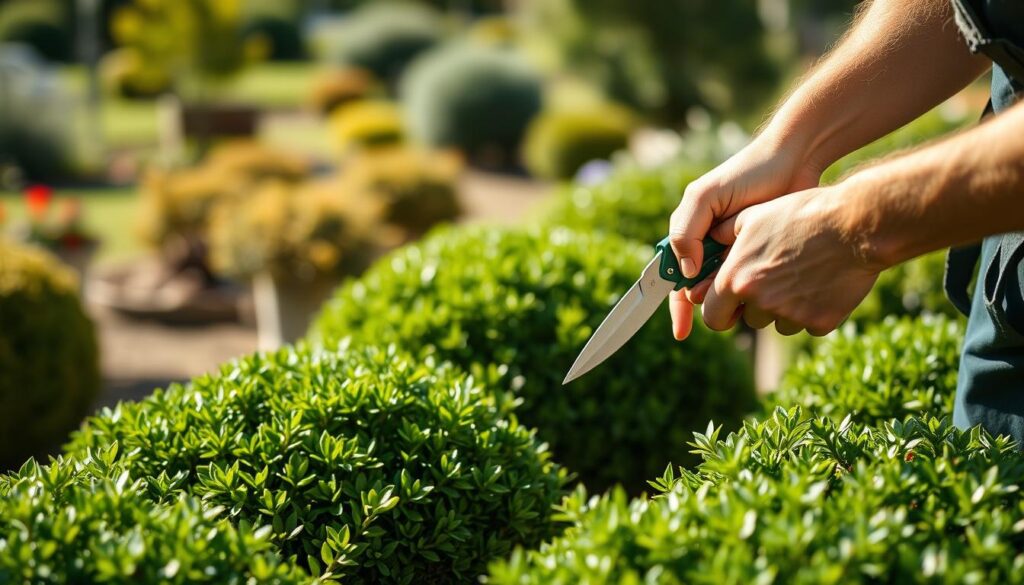Anúncios
Taking care of plants is key to their growth and well-being. With the right care tips, your green friends can really shine. This not only makes your space look better but also boosts your mood and cleans the air.
This guide will cover key tips for plant care. It aims to improve your gardening skills and help your plants do their best.
Anúncios
Understanding the Basics of Plant Care
To start gardening, it’s essential to know how to care for plants. They need the right amount of light, water, and healthy soil.
Different plants need different light levels like full sun or partial shade. Knowing this helps them grow well.
Anúncios
Watering correctly is crucial for plants. Too much or too little water harms them. It’s important to check the soil’s moisture level.
Good soil health is vital. Quality soil provides nutrients and supports roots. Make sure to keep the soil in good condition.
Learning these plant care tips is key for beginners. Taking time to understand these basics makes gardening more enjoyable.
Identifying Light Requirements for Your Plants
It’s vital to know what kind of light your plants need to stay healthy and grow. Plants need different amounts of sunlight based on where they originally come from. By putting them into three main categories, choosing the right light for your plants gets easier.
- Full Sun: These plants do best with more than six hours of direct sunlight every day. Think of tomatoes, basil, and sunflowers as examples.
- Partial Shade: These ones need about three to six hours of sunlight. Ferns, pansies, and some hydrangeas fit here.
- Full Shade: Some plants grow well even with very little light, less than three hours of direct sun. Hostas, ferns, and corydalis are good examples.
Watching how light moves in your garden is key to helping your plants thrive. Think about when and how strong the sunlight hits. This will help you figure out where to place your plants so they get just the right amount of sunlight.
The Importance of Proper Watering Techniques
Knowing how to water your plants correctly is key for their health and brightness. It impacts plant growth and life greatly. Check the soil’s moisture to ensure plants get the right water amount.
How to Determine When to Water Your Plants
To know when to water, feel the top 1-2 inches of soil. If it’s dry, your plants need water. Use soil that drains well to avoid root rot. By checking moisture often, you can create a watering routine that fits your plants.
Common Mistakes to Avoid in Watering
Some plant owners stick too closely to a schedule, not looking at their plant’s specific needs. This can lead to too much water, which harms roots. Watch out for these errors:
- Not checking soil moisture before watering.
- Using pots that don’t let water out.
- Thinking all plants need the same water amount.
If you’ve watered too much, let the plants dry before watering again. This way, you’ll see better growth.
Choosing the Right Soil for Healthy Growth
Choosing the correct soil type is key for plants to grow well. Good soil gives plants the nutrients they need and helps roots grow strong by draining water right. A great way to do this is by using potting mixes made especially for the kinds of plants you have.
Think about these soil options:
- Compost: Full of organic stuff, compost makes the soil better and helps it hold more nutrients.
- Perlite: It’s a light material that helps soil drain water fast, which is perfect for plants that like less water.
- Specialized potting mixes: These special mixes meet the specific needs of different plants, like how much water or what kind of pH they like.
It’s a good idea to test your soil to see what’s in it and its pH level. Knowing these things ensures your plants get the best place to grow.
https://www.youtube.com/watch?v=vuRC7BSD2JA&pp=0gcJCfcAhR29_xXO
Plant Maintenance: Key Fertilization Tips
Fertilizing plants right is key to their growth and health. It’s important to know when to feed them. Spring and summer are best because plants grow actively then.
When and How to Fertilize Your Plants
For the best results, keep these tips in mind:
- Use a balanced fertilizer with nitrogen, phosphorus, and potassium.
- Go for organic options like compost or manure for a natural approach.
- Put granular fertilizers down when watering to help plants soak up nutrients.
Using fertilizers wisely and at the right times helps your plants a lot.
Signs of Over-Fertilization
Look out for these over-fertilization signs:
- Burnt leaf tips show there’s too much salt in the soil.
- Weak growth means the plant might be stressed.
- Brown spots or edges on leaves point to nutrient imbalances.
Knowing these signs helps you fix problems early. This improves how you take care of your plants.
Creating a Stable Environment for Your Plants
It’s important to keep your plants healthy by providing a stable environment. A good start is to know what conditions indoor plants need to flourish. The perfect temperature for plants is between 65º to 75ºF to prevent stress from too much cold or heat.
Humidity is another key factor for plant health, especially for tropical plants that love moist air. In places where the air is dry, using a humidifier helps. Keeping plants away from places where the air blows directly on them, like near windows or AC units, is also important for their well-being.
To ensure stability in the plant environment, consider the following key factors:
- Maintain consistent temperature levels to avoid stress.
- Utilize humidifiers during dry seasons for moisture.
- Monitor humidity levels regularly, particularly in winter months.
- Position plants away from air drafts to protect them from fluctuation.
Watering Techniques: Deep vs. Shallow Watering
Watering plants is crucial for their care. We use deep and shallow watering methods. Each method affects plant health and growth differently.
Deep watering helps roots grow strong and deep. This approach means soaking the soil until water leaks out of pot holes. It makes sure the roots deep in the soil get water. This way, roots breathe better and plants become stronger.
Shallow watering only wets the top soil. This might make roots grow near the surface. Then, plants can easily get stressed or face drought. So, this method might not be best for healthy plants in the long run.
For best plant watering, know what your plant needs. Think about the soil type and pot size. These affect how water moves through the soil. Picking the right watering approach helps plants grow well and face hardships.
Understanding Pruning and Its Benefits
Pruning plants is a crucial part of keeping them healthy and growing well. It means taking off dead, broken, or sick parts. Doing this regularly makes the plant look better, grow more, and stops diseases from spreading.
Pruning also helps more air and sunlight reach every part of the plant. Without it, branches can get too crowded, causing airflow problems and fungus. Plants prune well get more light, which helps them make food and stay healthy.

The right time to prune is after winter but before spring fully begins. This is when plants are ready to start fresh growth. Using sharp and clean tools is key, so you don’t harm the plant more than you help it.
- Assess the plant for any dead or damaged branches.
- Use tools like pruning shears or loppers to make precise cuts.
- Remove any crossing branches that may rub against each other.
- Always clean your tools before and after use to prevent disease transmission.
Pruning does more than just make plants look good. It’s essential for their strong growth and health over time. By making pruning a part of your regular plant care, you’re helping your plants flourish all year round.
Pest Management: Keeping Your Plants Safe
Pest control keeps your garden healthy. Plants face threats from pests like aphids and spider mites. Using natural methods ensures safety from harmful chemicals.
It’s key to check your plants often. Look for unusual leaf colors or spots. Catching problems early stops bigger issues.
Caring for plants the right way can keep pests away. Strong plants fight off bugs better. Organic options to protect them include:
- Insecticidal soap, which targets soft-bodied insects.
- Neem oil, which keeps many bugs at bay.
- Companion planting, which pairs plants that turn pests away.
Keep your garden tidy by clearing out waste and dead plants. This reduces places for pests to live. Act fast at any sign of pests or disease. This helps your garden stay healthy and full of life.
DIY Self-Watering Solutions for Your Plants
Are you always busy but love having plants? Keeping soil moist is tough for you. DIY self-watering methods are perfect for helping your plants stay watered. They don’t need you to check on them all the time. You can use things you already have at home.
Simple Methods to Implement
Here are some easy DIY self-watering tricks for different plant types and pot sizes. These tips save you time and help your plants grow better.
- Wine Bottle Method: Clean an empty wine bottle and fill it with water. Make a tiny hole in the cork or cap. Turn the bottle upside down and stick it into the soil. It’ll slowly water the soil for days.
- Plastic Bottle Method: Take a clean two-liter soda bottle and make small holes in it. Bury the bottle partly in the soil, keeping the top above ground. Fill the bottle with water. It’ll slowly water the soil, encouraging roots to grow deep.
- Self-Watering Bucket Garden: Turn a 5-gallon bucket into a self-watering planter. Cut the bucket’s lid to make a space for soil and water. Drill holes in the lid and add a piece of perforated drain tile. Use plastic tubing for a water inlet. Then, add a damp growing mix. This way, your plants get the moisture they need.
- Plastic Bottle Drip System: Take a plastic bottle and drill tiny holes in its cap. Fill with water and place it upside down in the soil. The water drips slowly, keeping your plant watered.
These DIY self-watering solutions make plant care easier. You can relax, knowing your plants won’t dry out. Plus, using recycled containers saves resources and gives your plants a lovely home.
The Benefits of Seasonal Care Adjustments
Knowing how to take care of plants during different seasons is key to keeping them healthy. Each season brings its own set of challenges and conditions. This means we need to change how we look after our plants. In the warmer months of spring and summer, plants grow more. They need more water and regular fertilizer.
But when it gets colder in fall and winter, plants don’t grow as much. They enter a rest period. It’s important to cut back on watering and change how we fertilize them. This helps avoid putting too much stress on them.
Making these changes in care with the seasons helps plants stay healthy. It’s important to notice changes like less light or drier air. These changes can affect how plants grow. For plants outside, we need to protect them from cold frost. Indoor plants might need to be moved to get enough light.
To take good care of your plants all year, keep these tips in mind:
- Watch the temperature and humidity to adjust your care.
- Change how much you water based on if your plants are growing or resting.
- Pick the right fertilizers for the current season.
- Keep an eye out for pests when the seasons change.
Conclusion
As we end our guide on plant care, let’s highlight the important steps. Proper watering, light checking, and choosing the right soil and fertilizer are key. These practices will help your plants grow well and beautify your space.
Don’t forget to trim your plants and keep an eye out for bugs. These steps are crucial for healthy, good-looking plants. Looking after your plants brings joy and a sense of achievement into your life.
Caring for plants is rewarding in many ways. It can improve the air, lower stress, and help the community. By taking care of plants, you’ll create a lovely indoor garden and connect more with nature.



